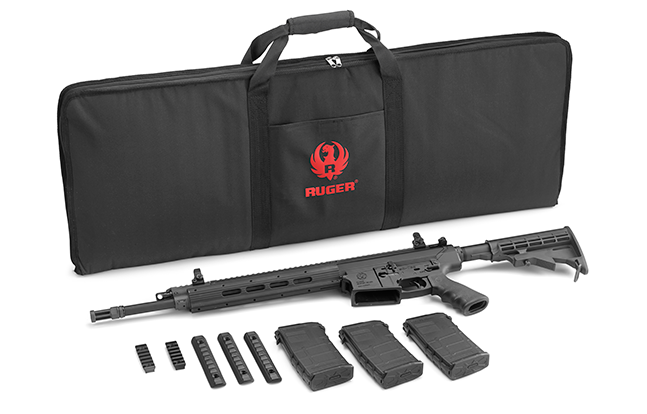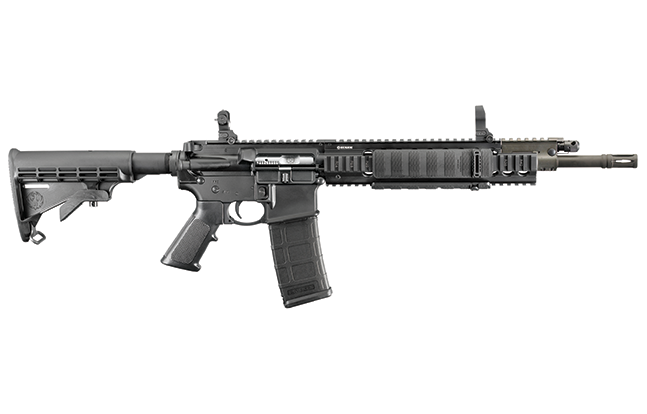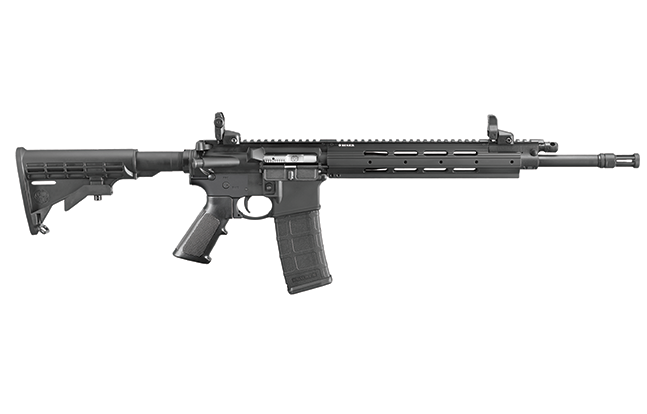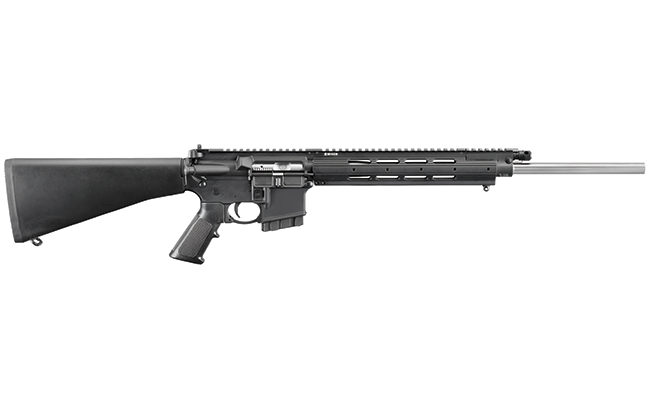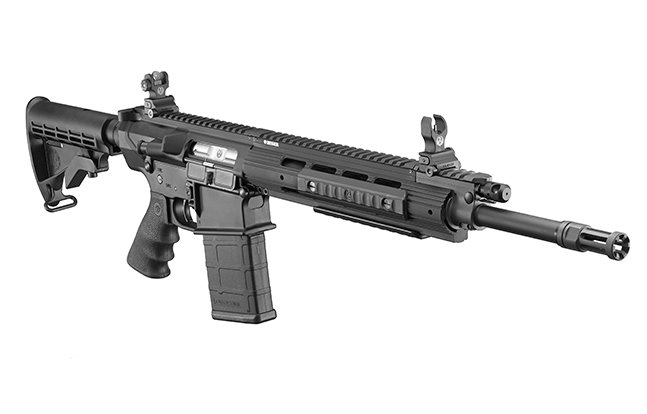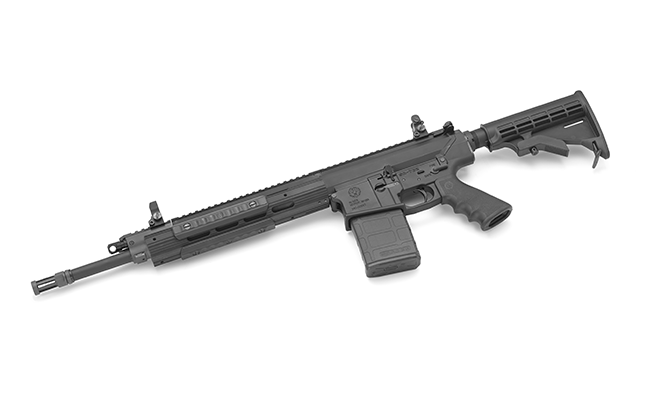Sturm, Ruger & Co. is a leading manufacturer in the U.S. for all firearm categories, including sporting, competition or personal defense.
Ruger.30’s SR-556 and recently introduced SR-762 AR-pattern rifles solidify Ruger’s all-encompassing position in the marketplace. Ruger’s entrance to the AR realm is an obvious embrace of how popular the AR platform is. Ruger’s staunch reputation for American-made quality and customer service within the U.S. gun culture is sure to at-tract customers for its AR offerings. Ruger’s place in the American gun psyche lends credence to its products compared to other manufacturers who may not be as well known within the general shooting public. This stems back to the 1960s, when Ruger’s reputation was first established.
It is no secret that the AR is not only the best-selling civilian and law enforcement rifle in the U.S., but also the world with the U.S. equipping/training so many armies around the globe. This has caused many manufacturers to jump on the AR bandwagon in recent years by offering their own versions. Of late, the most attention seems to be on “improving” the AR platform via developing piston-driven ARs in lieu of Eugene Stoner’s original gas-impingement design. Whether or not piston-driven ARs are superior to their gas-impingement brethren often generates heated discussion. One thing that is not debatable is the number of manufacturers rushing to create piston-driven ARs. This leads us to Ruger’s entries into the AR field—the SR-556 and SR-762.
Advertisement — Continue Reading Below
SR-556
The SR-556 represents one of the latest gas-piston ARs introduced into the U.S. market. I do find it indicative that the ultimate decision came down to introduce a piston-driven AR rifle versus a traditional impingement design. Ruger describes its short-stroke piston as a two-stage affair that eliminates the sharp pulse often associated with other piston ARs as the op-rod strikes the flat-faced carrier key located on the bolt carrier. Ruger’s transfer rod lies behind the gas block regulator and rests between captive springs and bushings. The transfer rod is acted on by the piston between it and the gas port regulator, sending it rearward to work the SR-556’s action. The movement of the action provides a functional cleaning of the transfer rod. The same pattern of design is followed with the SR-556’s big brother, the SR-762.
Ruger’s SR-556 product line is comprised of four model types: Standard, Carbine, E-Model and Varmint Target. The flagship of the Ruger SR-556 lineup is the Standard model. The Ruger SR-556 line-up is not marketed as the least expensive AR option with a price near $2,000. However, Ruger does provide a rifle that is good value in terms of what is included with it. For example, three Magpul 30-round magazines are included, along with a very functional soft case for the rifle. Along these lines, quality iron sights are also included, serving as stand-alone battle sights or folded-down backup sights once an optic is mounted. An adjustable buttstock and Hogue pistol grip further rounds out the SR-556 Standard model. In an attention-to-detail moment, Ruger includes a sight adjustment tool with the rifle. Ruger accepts that rails are here to stay on the AR platform by providing a quad-rail forend for a user to configure the rifle as they see fit.
Advertisement — Continue Reading Below
Another Ruger SR-556 model is the Carbine Model 5913 variant. As with all SR-556s, it is chambered in 5.56mm. It is one of lighter Ruger SR-556 AR versions, weighing in at slightly over 7.17 pounds. It features a minimized rail design and slim-profile barrel that helps to save weight compared to the Standard model. The SR-556 Model 5913 carbine shows Ruger versatility in satisfying customer needs by not using a full-length quad rail, but instead a lower profile handguard with adjustable 3-inch Picatinny rail sections. The top of the rifle, from the back of the receiver to the front gas block, has a full-length Picatinny rail. Ruger’s piston AR design has a four-position gas regulator, allowing for the user to completely cut gas off (Setting #0), in effect making the rifle a manually operated rifle. The widest setting, Setting #3, opens up the gas system in case the rifle is extremely fouled or underpowered ammunition is encountered. Setting #2 is the normal setting. The SR-556 Carbine Model 5913 has a pinned flash suppressor to minimize barrel length and weight. The overall length of the rifle is 31 inches to 34.25 inches, depending on adjustable buttstock position. A mil-spec trigger group rides in the Ruger’s lower receiver. An over-engineered match or any kind of competition trigger that can malfunction or go out of adjustment is not suitable for a fighting rifle. All of the Ruger features, however, are intended for maximizing effectiveness during a fight or realistic training on the range. The key component in a fighting rifle is reliability.
SR-762
Ruger has taken its concept of the AR rifle another step forward with its SR-762 in .308/7.62mm. The SR-762 is a short-stroke gas piston AR following a similar pattern of Ruger’s SR-556 introduced previously. As stated above, Ruger wanted to minimize the sharp impulse of the piston striking the bolt carrier typically found in short-stroke ARs. The Ruger piston delivers two smaller impulses to the operating rod in lieu of the one longer, sharper impulse seen on other AR designs. The piston fitting inside the gas regulator is acted upon initially only by a small amount of gas once cartridge ignition occurs and moves down the barrel. The smaller nipple area of the piston moves about 0.19 inches in unlocking the action. Once this happens, the larger surface area of the piston is exposed, allowing gas pressure controlled by the regulator to affect it and cycle the action during the second stage of piston operation. The bullet has left the barrel at this stage. In crude summary, the first stage acts to alleviate the state of inertia in the action by a “softer” impulse, which is then followed by the stronger pulse working the action. This is especially important in a .308/7.62mm AR. The net sum of this is less traumatic strike on the action, as typified by other short-stroke piston ARs, in theory leading to better accuracy and better durability in the bolt carrier. Ruger is “all in,” making the SR-762 one of the most durable piston-driven ARs on the market by chrome-plating the piston and bolt carrier, along with chrome lining the mil-spec 41V45, 1-in-10-inch twist, hammer-forged barrel. The SR-762’s forend rail system also follows the pattern of the SR-556 Model 5913 Carbine in terms of placing railed sections where needed in lieu of a full-length quad rail.
Advertisement — Continue Reading Below
Typical of the Ruger methodology, an AR design was not hastily introduced in knee-jerk fashion. Ruger decided to enter the fray only after thoroughly exploring the topic and by designing its version of a short-stroke, push-rod, piston-driven system for the AR. Ruger’s renditions of the AR in the form of the SR-556, chambered in 5.56mm, and SR-762, chambered .308/7.62mm, are refreshing in the tweaks made to make them Ruger products and separating them from other AR models.
For more information, visit ruger.com.
